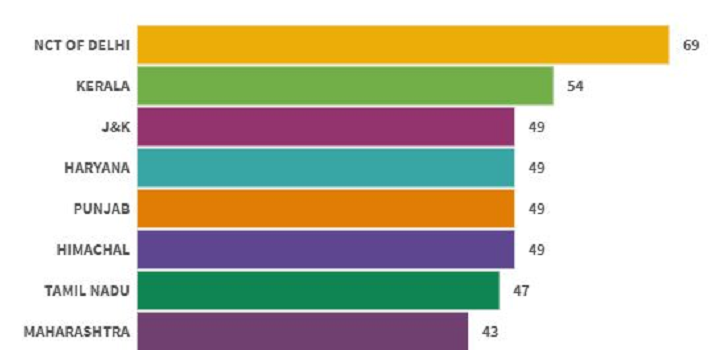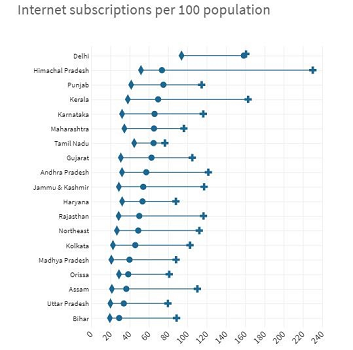Prelim Snippets 12-11-2019
1.India Internet 2019
Why in News?
- Internet And Mobile Association of India (IAMAI) has recently released the report “India Internet 2019”.
About:
- According to the report, Internet penetration rate is highest in Delhi NCR (69%) followed by Kerala (54%).
- The lowest penetration rate was in Odisha (25), Jharkhand (26) and Bihar (28).
- Internet penetration is defined as number of individuals aged above 12 per 100 populations who accessed the Internet during a particular period.
- It also noted that Kerala, Tamil Nadu and Delhi have the highest proportion of female Internet users.

INTERNET PENETRATION, 2019
- In terms of Internet subscriptions per 100 populations, Delhi, Punjab and Himachal Pradesh and Kerala topped the list.
- The lowest subscriptions are from Bihar and Uttar Pradesh.
- Kerala is among States with a huge gap between the number of rural and urban Internet connections. This is also the case in Delhi and Himachal Pradesh.

2.Shilpostav 2019
Why in News?
- Union Minister for Social Justice & Empowerment visited the “Shilpostav- 2019” to encourage the artisans at Dilli Haat, INA, in New Delhi.
About:
- Shilpostav- 2019 is the annual fair of artisans from across the country, belonging to the weaker sections of the society.
- It is organized by the Ministry of Social Justice and Empowerment.
- The artisans assisted by the Apex corporations of the Ministry Social Justice and Empowerment i.e. National Backward Classes Finance & Development Corporation (NBCFDC), National Scheduled Caste Finance & Development Corporation (NSFDC), National Handicapped Finance & Development Corporation (NHFDC), National Safai Karamchari Finance & Development Corporation (NSKFDC) and National Trust are displaying and selling their products.
- The range of products in this fair include dress materials, leather, cane & bamboo products, hand embroidery, bead products, block printing, wooden toys, handloom etc.
3.Article 142
Why in News?
- The Supreme Court has stated about Article 142 in its recent Ayodhya Verdict.
About:
- The Article provides that “Supreme Court in the exercise of its jurisdiction may pass such decree or make such order as is necessary for doing complete justice in any cause or matter pending before it”.
- Previously, Article 142 has been used to bring justice to various deprived sections of society or to protect the environment. For instance, it was used for the cleansing of the Taj Mahal, the marble of which was getting yellow due to sulphur fumes from surrounding industries.
- Similarly, it was also applied in the Union Carbide case to bring relief to thousands of persons affected by the gas leak. Article 142 of the Constitution was also put to use in the release of thousands of undertrials who were in jails for periods exceeding their sentences.
4.Suranga Bawadi
Why in News?
- Suranga Bawadi, ancient subterranean tunnels in Vijayapura of Karnataka, is now set to get funding for restoration.
About:
- Suranga Bawadi is an integral part of the ancient Karez system of supplying water through subterranean tunnels built during Adil Shahi era in Vijayapura.
- A New York-based NGO has included it in the World Monument Watch list for 2020 along with 24 other monuments from across the world.
- The monument has been selected under the ‘Ancient Water System of the Deccan Plateau’ by World Monuments Fund [the NGO], which monitors restoration of ancient monuments across the globe.
- ‘Karez’ which is believed to be one of the best systems in the world is now in bad condition due to the lack of maintenance.
- Though the Karez system was built in the 16th century by Ali Adil Shah–I, his successor, Ibrahim Adil Shah–II, brought in several changes by adding more structures to strengthen it.According to historians, the Adil Shahis built the magnificent underground system to supply water to the city, which had a population of nearly 12 lakh then.
5.Organisation of American States
Why in News?
- The Organization of American States (OAS) has exhorted Bolivian lawmakers urgently to resolve the crisis in its state.
About:
- Organization of American States (OAS) formed in 14th April, 1890 to promote economic, military, and cultural cooperation among its members, which include almost all of the independent states of the Western Hemisphere.
- The prime objective of the formation was to prevent any outside state’s intervention in the Western Hemisphere and to maintain peace between the various states within the hemisphere.
- The Governing Bodies of the Organization of American States (OAS) is consists of General Secretariat, the Permanent Council, the Inter-American Council for Integral Development, and a number of committees.
- General Secretariat: It is the supreme decision-making body and convenes once every year in a regular session.
- The staffs of the General Secretariat are consists of personnel chosen mainly from the member states, with consideration given to geographic representation. Staff members are considered international civil servants.
- Permanent Council: It involves in implementing mandates from the General Assemblies, designing and assessing activities to promote democracy and strengthen human rights, considering requests from members, debating and approving resolutions on current issues, and dealing with reports from subsidiary organs.
6.Jal Jeevan Mission
Why in News?
- The Union Minister for Water Resources reviewed the Jal Jeevan Mission in the southern states.
Jal Jeevan Mission:
- The Mission was announced in August 2019.
- The chief objective of the Mission is to provide piped water supply (Har Ghar Jal) to all rural and urban households by 2024.
- It also aims to create local infrastructure for rainwater harvesting, groundwater recharge and management of household waste water for reuse in agriculture.
- According to the data published in various reports, about half of the country’s households don’t have access to piped water supply.
- It is an urgent requirement of water conservation in the country because of the decreasing amount of groundwater level.
- Therefore, the Jal Jeevan Mission will focus on integrated demand and supply management of water at the local level.
Benefits:
- Household pipeline water supply
- Clean and drinkable water
- Recharge of groundwater level
- Better local infrastructure
- Less water-borne diseases
- Less water wastage
7.Swachh – Nirmal Tat Abhiyaan
Why in News?
- A week-long intensive Beach Cleaning Drive in 50 identified beaches of India begins.
Swachh – Nirmal Tat Abhiyaan:
- The programme was launched by the Ministry of Environment, Forest and Climate Change to strive to make Indian beaches clean and create awareness amongst citizens about the importance of coastal ecosystems.
- The identified beaches are in 10 coastal States/Union Territories (UTs) namely Gujarat, Daman & Diu, Maharashtra, Goa, Karnataka, Kerala, Tamil Nadu, Puducherry, Andhra Pradesh, and Odisha.
- The beaches have been identified after consultation with the states/UTs.
- The cleaning drives in all beaches are being undertaken, involving school/college students of eco-clubs, district administration, institutions, volunteers, local communities and other stakeholders. State Nodal Agencies for the eco-clubs will be facilitating the week-long intensive cleanliness drive in all 10 States/UTs.
- Environment Education Division of the Ministry of Environment and Society of Integrated Coastal Management (SICOM) under the aegis of the Ministry of Environment will be responsible for the overall coordination for the drive.
- On completion of the drive, the best three beaches will be suitably awarded.
8.India-ASEAN Business Summit
Why in News?
- Union Minister addressed the inaugural session of the India-ASEAN Business Summit.
- The minister mentioned in his speech the Bamboo Industrial Park coming up at Dima Hasao district in Assam.
Bamboo Industrial Park:
- This is India’s first Bamboo Industrial Park.
- The project is expected to be completed by March 2021.
National Bamboo Mission:
- National Bamboo Mission is a Centrally Sponsored Scheme started in the year 2006-07.
- The scheme was later subsumed under the Mission for Integrated Development of Horticulture (MIDH) for the years 2014-15 and 2015-16.
- The scheme aims at promoting the growth of Bamboo sector through the area based regionally differentiated strategy.
India-ASEAN Business Summit:
- The theme for the Summit is ‘Today, Tomorrow, Together’.
- It is being organised to strengthen trade and investment flows with ASEAN.
- The objective of the conference is to enhance the trade trajectory between India and ASEAN nations to new highs.
- Senior government officials from India and the ASEAN nations are interacting with the business community of India and ASEAN for the promotion of bilateral trade and investments.Sessions being held are focussed on sectors such as infrastructure, tourism, e-commerce, IT/ITES, fintech, education, skill development, healthcare and pharmaceuticals, food processing and agriculture.
- There will also be a special session on Focus Vietnam – Growing Trade & Commerce between India & Vietnam.
- More than 60 delegates from 10 ASEAN countries and more than 200 delegates from India are participating in the summit.








